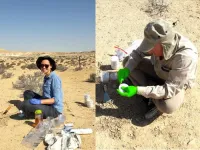(Press-News.org) Prolonged droughts followed by sudden bursts of rainfall – how do desert soil bacteria manage to survive such harsh conditions? This long-debated question has now been answered by an ERC project led by microbiologist Dagmar Woebken from the Centre for Microbiology and Environmental Systems Science (CeMESS) at the University of Vienna. The study reveals that desert soil bacteria are highly adapted to survive the rapid environmental changes experienced with each rainfall event. These findings were recently published in the prestigious journal Nature Communications.
Drylands cover over 46% of global land area and are expanding, not only due to climate change but also unsustainable land management practices. While plants are seldom encountered in deserts, invisible life thrives belowground. Microorganisms located in the so-called biocrust (the top millimeters to centimeter of the desert soil) enrich the soil with carbon and nitrogen, and also help prevent soil erosion and retain water. But these microbes live in a challenging environment, facing long periods of drought with infrequent rain. Until now, it was unclear how they could maintain important ecosystem functions under such conditions. Using state-of-the-art methods in microbial ecology, Dagmar Woebken's team gained insights into microbial life in these soils.
Desert soil bacteria endure long drought periods in a state of dormancy, but are reactivated in response to rainfall events, which are short and very rare. The researchers uncovered a kind of "all-in" reactivation strategy in the biocrusts of the Negev Desert, Israel. The bacteria make the most of rainfall events – within this narrow window of activity, almost all microbial soil diversity (as well as individual cells) become active. "When we simulate a rainfall event in the laboratory, we observe that within the first 15 to 30 minutes, almost all taxonomic groups switched from a resting mode to an active mode," explains Dimitri Meier, co-first author of the study." This is a remarkable characteristic of desert soil bacteria, as in other types of soil many groups of bacteria take much longer to reactivate." When reactivated, the bacteria would quickly begin to generate energy and repair their genomes.
In the study, the researchers simulated rainfall events with stable isotope labeled water – water containing heavy hydrogen. Using NanoSIMS, they examined individual cells to see which of them had incorporated the heavy hydrogen atoms. "With this approach, we can reveal the fraction of biocrust cells that reactivate in a rain event. We can also infer if they can grow in short rain events that in arid deserts often only last 1 to 2 days," explains Stefanie Imminger, PhD candidate and co-first author of the study. "We found that almost all biocrust cells reactivate, but that in these short rain events only a small proportion of the cells would be able to double." A large proportion of the biocrust cells can therefore use rain events to regenerate and prepare for the next drought, but cell division does not occur.
"These data help us understand how biocrust bacteria make optimal use of the short activity windows they experience in deserts. They are ideally adapted to withstand short-term changes in soil water content, a very stressful situation for the cells. This allows them to survive the sudden increase in water content during rain, as well as the subsequent drying out. Additionally, the diverse microbial community is capable of immediate reactivation, which is of great benefit when it must return to a dormant state within a few hours to days," says Dagmar Woebken, principal investigator of the study.
The findings of this study are relevant not only for desert areas but also for other regions. The ability to survive water limitation will become increasingly important for soil microorganisms in temperate regions, as the frequency and intensity of droughts is increasing due to climate change. Insights gained from desert soil research can help to understand which features make soil microorganisms successful in surviving these challenges.
END
How soil microbes survive in harsh desert environments
As desertification spreads worldwide, scientists discover how desert microbes endure harsh drought periods
2024-04-17
ELSE PRESS RELEASES FROM THIS DATE:
Toronto researchers uncover human DNA repair by nuclear metamorphosis
2024-04-17
Researchers at the University of Toronto have discovered a DNA repair mechanism that advances understanding of how human cells stay healthy, and which could lead to new treatments for cancer and premature aging.
The study, published in the journal Nature Structural and Molecular Biology, also sheds light on the mechanism of action of some existing chemotherapy drugs.
“We think this research solves the mystery of how DNA double-strand breaks and the nuclear envelope connect for ...
Fluctuating coffee prices put mental pressure on Vietnamese farmers
2024-04-17
While your invigorating morning coffee may become cheaper when there are large fluctuations in the world market price, they are a major additional psychological burden for the farmers who grow the coffee.
This is documented in a new international study on the effect of income uncertainty on the mental health of Vietnamese coffee farmers.
"Our results suggest that not only poverty, but also the risk of poverty caused by fluctuating prices has a significant additional negative effect on the mental well-being of farmers in low-income countries," says Finn ...
Silver-based micromotors that eliminate bacteria moving freely in aqueous media
2024-04-17
In ancient Greece, over 3000 years ago, wise men used silver salts to prevent wounds from becoming infected. These salts continued to be used until Alexander Fleming discovered the first antibiotic "just" 100 years ago. The use of antibiotics represented a major breakthrough in the treatment of infectious diseases, but resistance soon began to emerge. Bacteria, which have been on the planet longer than us, have found ways to overcome different antibiotics, and today antibiotic resistance is a major global health problem.
In times when everything evolves ...
New research shows urgency to act on Nigeria’s trans fat elimination policy
2024-04-17
Significantly reducing trans fat levels in the Nigerian food supply could prevent approximately 10,000 heart disease deaths and save 90 million USD (12 billion Naira, ₦) in healthcare costs over a decade. New findings by The George Institute for Global Health on the health and economic benefits of enacting the country’s trans fat elimination policy were published today in BMJ Global Health.
In 2023, Nigeria followed South Africa as only the second African country to adopt a best practice trans fat ...
Healthy diet lowers heart disease risk in breast cancer survivors
2024-04-17
A new paper in JNCI Cancer Spectrum, published by Oxford University Press, finds that following a healthy diet lowers the risk of cardiovascular disease in breast cancer survivors.
Cardiovascular disease is the top non-breast cancer related cause of death in women with breast cancer. There are more than 3.8 million female breast cancer survivors in the United States. These women are at higher risk for cardiovascular disease than women who have not had breast cancer. This is likely due to the cardiotoxic effects of breast cancer treatment, as well as common risk factors for both breast cancer and cardiovascular disease, such as aging, lack of exercise, ...
From defects to order: Spontaneously emerging crystal arrangements in perovskite halides
2024-04-17
Perovskites are among the most extensively studied materials in modern materials science. Their often unique and exotic properties, which stem from perovskite’s peculiar crystal structure, could find revolutionary applications in various cutting-edge fields. One intriguing way of realizing such properties is through the precise ordering of a perovskite’s defects, such as vacancies or substitutions.
In oxide chemistry, scientists have known for a long time that oxide defects can spontaneously and consistently arrange themselves throughout the crystal lattice, once they reach certain concentrations (e.g. integer ratio). This emerging ...
Responsible AI could contribute to global peace, experts suggest
2024-04-17
Artificial intelligence (AI) could be a vital tool to promote peace, prevent violent conflict, and safeguard human rights – if used responsibly, experts say.
Much focus has been on AI’s potential for catastrophic harm from powering drone swarms for international warfare to generating deep fakes which spread misinformation and prejudice.
But authors Branka Panic and Dr Paige Arthur say AI-driven technology should also be seen as a potential force for good in conflict-torn countries to ‘wage peace’.
With the ongoing wars in Ukraine and Gaza and three decades on from the Rwandan genocide, their book AI for Peace highlights concrete ways that AI tools are being used to ...
Seychelles beach cleans demonstrate potential for citizen science to tackle marine litter
2024-04-17
Volunteer clean-ups have resulted in almost nine tonnes of marine litter being cleared from beaches across the Seychelles, in what researchers have described as a powerful demonstration of the potential of citizen science.
More than 1,220 volunteers were recruited to clear 52 beaches on ten islands at various points between June 2019 and the end of July 2023. In that time, they surveyed around 930,000m2 of beaches, with volunteers picking up items ranging from foam and rubber to metals and plastics.
In total, the ...
Dual-beamline photoelectron momentum microscopy upgrade revolutionizes valence orbital analysis
2024-04-17
The world's first dual-beamline photoelectron momentum microscope has been developed at the UVSOR Synchrotron Facility, Japan. This innovative experimental station brings breakthroughs in studying the behavior of electrons in materials governing material properties, particularly in analyzing valence orbitals.
Understanding the behavior of electrons in materials is crucial for the advancement of materials science and device engineering. Conventional photoelectron spectroscopy provides deep insight into the nature of the electronic structure of solids. Currently, the challenge of researching electronic structures on the micrometer scale is being pursued all over the world. ...
Real-time detection of infectious disease viruses by searching for molecular fingerprinting
2024-04-17
A research team consisting of Professor Kyoung-Duck Park and Taeyoung Moon and Huitae Joo, PhD candidates, from the Department of Physics at Pohang University of Science and Technology (POSTECH) has engineered “broadband nanogap gold spectroscopic sensor” using a flexible material capable of bending to create a controlled gap. With the developed technology, it is possible to rapidly test various types of materials, including infectious disease viruses, using only a single nano-spectroscopic ...
LAST 30 PRESS RELEASES:
New expert guidance urges caution before surgery for patients with treatment-resistant constipation
Solar hydrogen can now be produced efficiently without the scarce metal platinum
Sleeping in on weekends may help boost teens’ mental health
Study: Teens use cellphones for an hour a day at school
After more than two years of war, Palestinian children are hungry, denied education and “like the living dead”
The untold story of life with Prader-Willi syndrome - according to the siblings who live it
How the parasite that ‘gave up sex’ found more hosts – and why its victory won’t last
When is it time to jump? The boiling frog problem of AI use in physics education
Twitter data reveals partisan divide in understanding why pollen season's getting worse
AI is quick but risky for updating old software
Revolutionizing biosecurity: new multi-omics framework to transform invasive species management
From ancient herb to modern medicine: new review unveils the multi-targeted healing potential of Borago officinalis
Building a global scientific community: Biological Diversity Journal announces dual recruitment of Editorial Board and Youth Editorial Board members
Microbes that break down antibiotics help protect ecosystems under drug pollution
Smart biochar that remembers pollutants offers a new way to clean water and recycle biomass
Rice genes matter more than domestication in shaping plant microbiomes
Ticking time bomb: Some farmers report as many as 70 tick encounters over a 6-month period
Turning garden and crop waste into plastics
Scientists discover ‘platypus galaxies’ in the early universe
Seeing thyroid cancer in a new light: when AI meets label-free imaging in the operating room
Neutrophil-to-lymphocyte ratio may aid risk stratification in depressive disorder
2026 Seismological Society of America Annual Meeting
AI-powered ECG analysis offers promising path for early detection of chronic obstructive pulmonary disease, says Mount Sinai researchers
GIMM uncovers flaws in lab-grown heart cells and paves the way for improved treatments
Cracking the evolutionary code of sleep
Medications could help the aging brain cope with surgery, memory impairment
Back pain linked to worse sleep years later in men over 65, according to study
CDC urges ‘shared decision-making’ on some childhood vaccines; many unclear about what that means
New research finds that an ‘equal treatment’ approach to economic opportunity advertising can backfire
Researchers create shape-shifting, self-navigating microparticles
[Press-News.org] How soil microbes survive in harsh desert environmentsAs desertification spreads worldwide, scientists discover how desert microbes endure harsh drought periods








